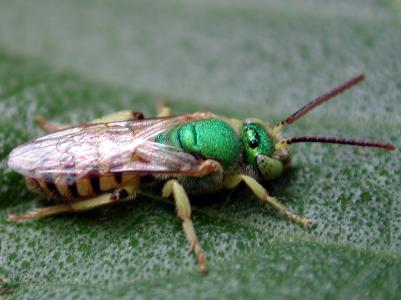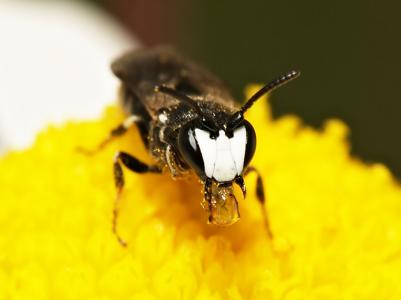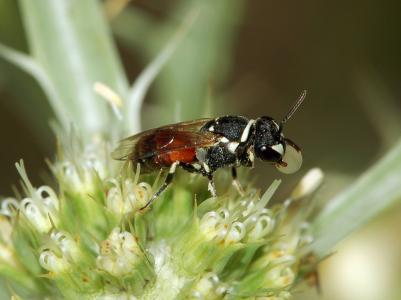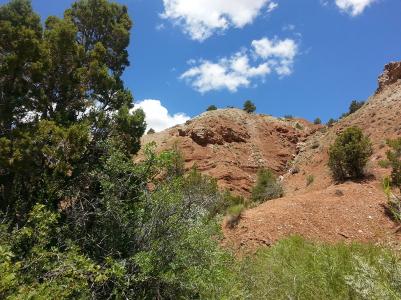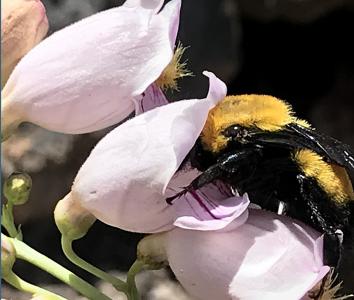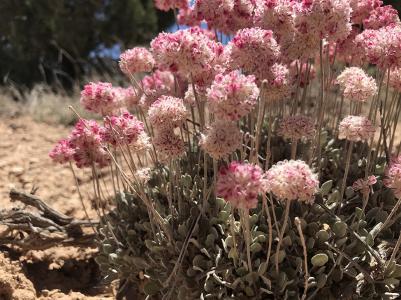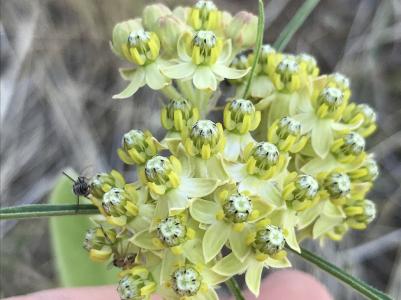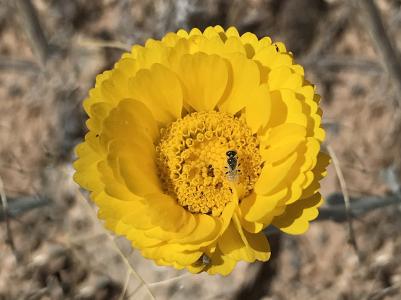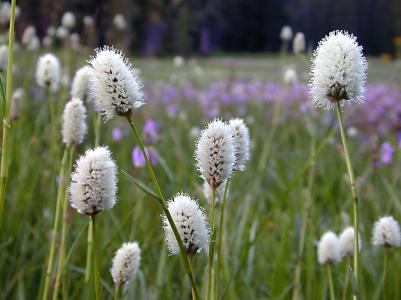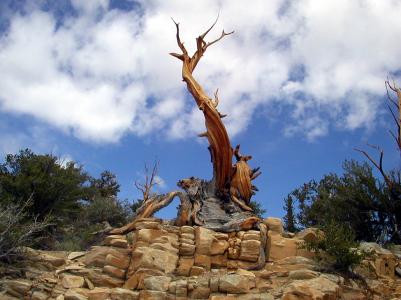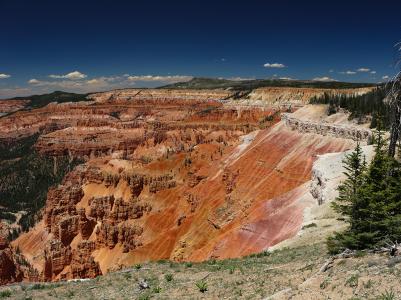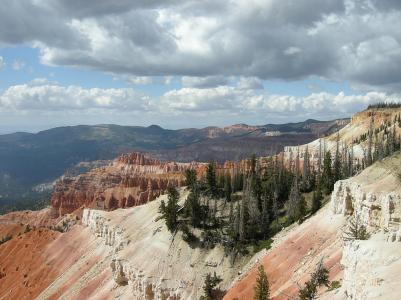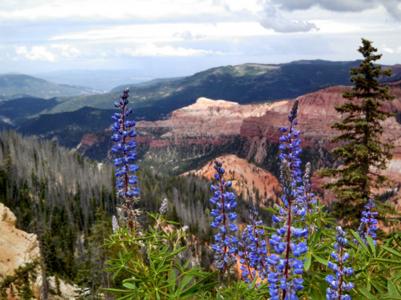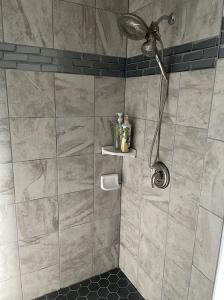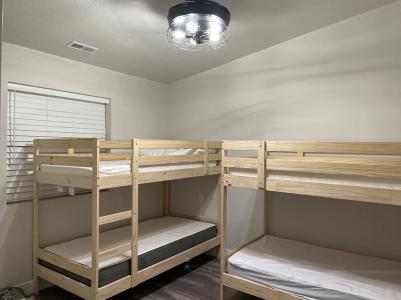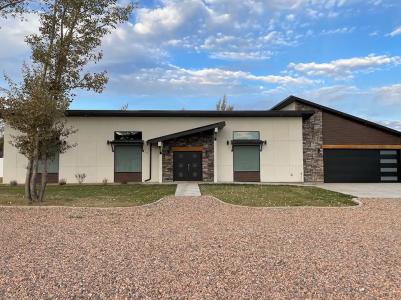.
Click here to view this expedition's photo gallery!
.
.
Cracking the Code: the Mysteries of Native Bees in Utah
Expedition Briefing
.
Please read the following information before leaving for your expedition.
It provides the most accurate information available and will likely answer any questions you have about the project. You may also reach out to your Program Coordinator with any questions you may have.
.
COVID-19 Enhanced Health and Safety Measures
This project has been amended to incorporate several health and safety measures to allow responsible fielding of teams during the COVID-19 pandemic. Please refer to the COVID Disclosure Form for more details.
BEFORE FIELDING
- Vaccination against COVID-19 is required for all participants. Staying up to date with your vaccinations, including receiving booster doses if available, is strongly encouraged.
- Become familiar with and abide by the local COVID requirements—these may include up to date vaccinations, including boosters, mandatory quarantine, or other guidelines.
- Do not travel to your Earthwatch expedition or program if you:
- are experiencing symptoms consistent with COVID-19 (cough, shortness of breath or difficulty breathing, fever, chills, muscle pain, sore throat, or new loss of taste or smell),
- are confirmed or suspected as having COVID-19 within the past 10 days
- have been in close contact with someone suspected or confirmed as having COVID-19 in the past 10 days
- You are highly encouraged to take a COVID-19 test one day before or the morning of your rendezvous, before meeting up with your team.
WHILE IN THE FIELD
- Face masks will be required in line with local regulations and/or when instructed by project leadership. In areas or on projects where mask use is no longer required, the use of face masks will be optional. Any individual who wishes to continue to mask will be supported in that decision.
- Participants and project staff will continue to wash or sanitize hands frequently and maintain physical distance whenever possible.
- All team members will be asked to monitor their own health through daily health checks.
- Recreational activities may be limited or require additional face mask requirements to reduce the risk of exposure to team members or to the local community.
- Meals and activities will take place outside whenever possible.
- Ventilation will be increased indoors and within enclosed vehicles whenever possible
The Research
Utah is home to 40 million acres of public lands, protecting a breathtaking range of ecosystems. From rocky canyons to lush forests to arid deserts, these protections not only safeguard the diverse geography, but also the enormous biodiversity of plants and animals living there. These protected lands are especially important for safeguarding pollinator diversity, as Utah has the fourth-highest bee diversity in the United States. In fact, the Grand Staircase National Monument is home to at least 660 different species of bees alone. However, climate change, the introduction of invasive species, and other human influences could threaten these species, collapsing the complex web of ecological networks in the Colorado Plateau.
With populations of native bees plummeting, some scientists and commercial farmers want to introduce western honey bees (originally brought to the U.S. by European settlers) to the pesticide-free protected lands in Utah. But scientists are not sure how the introduction of this invasive species will affect these ecosystems. Will honey bees outcompete native species for resources? Will some native plants be left without pollinators? How will honey bees affect the intricate web of interactions between native bees and native plants?
Dr. Jackie Grant is developing a cutting-edge research method to answer these questions. She and her team, with the help of Earthwatch volunteers, are creating a reference library of native bee genetic codes. The researchers will be looking at small unique segments of the bee’s DNA using a technique known as DNA barcoding. Each DNA barcode they collect will be cataloged in a library, which will allow researchers around the world to trace which bee species interact with which plants by simply processing the DNA left behind by bees. By revealing this tangled web of species interactions, scientists will be able to better predict how imminent threats, such as honey bees and climate change, will impact the habitats and resources of native bee species.
Building this database requires that pollinators are killed to obtain accurate samples of their DNA barcode; however, relatively few samples are required to barcode a new species and allow researchers to learn from it for decades. The aim of this project is to build this collection of genetic data to allow researchers to study bee interactions without killing bees, known as destructive sampling. Once researchers can track bees by the DNA they leave on various plants, they won’t need to collect pollinators to study their interactions.
Dr. Grant and her team will also be investigating another method of tracking pollinators: acoustic monitoring. Starting with bumble bees, they’ll be listening to recordings of pollinators and identifying the characteristic buzz that species makes. This will allow researchers to determine bumble bee abundance in an area without interacting with the bees. They hope to expand the audio surveys to other species as another means to survey bee biodiversity without destructive sampling.
This research will help pioneer a new way to investigate species interactions, allowing scientists to study pollinators without interacting directly with those species. The data collected through this project will give land managers and conservationists the knowledge they need to most effectively preserve native bees, native plants, and the health of these spectacularly biodiverse landscapes.
Research Aims
The research has four core objectives:
- Measure the biodiversity of pollinators in a variety of habitats
- Create DNA barcode libraries for native plants and pollinators of southern Utah
- Assess the potential for acoustic surveys for bumble bees
- Construct pollination networks to evaluate the effects of restoration efforts and the potential impact of human activities, such as commercial honey bee farming
The ultimate goal of this project is to decrease the amount of destructive sampling needed to study pollinators by establishing a genetic and acoustic library of pollinators in southern Utah. These libraries will allow researchers to investigate and describe the ecological networks between pollinators and plants. Understanding these networks will allow land managers to enact policies that can better preserve pollinator networks and essential pollinator habitat. These libraries will also allow researchers and managers to assess how pollinator and plant populations change in response to management actions, human use of the land, and climate change.
A secondary aim of this project is to enhance pollinator and wildlife habitat on public lands by working with federal partners to develop seed banks for native plant species. Depending on the time of year, volunteers may help collect seeds of native plants. Those seeds will be used by the Colorado Plateau Native Plant Program to develop seed banks that land managers can use to restore and maintain public lands. The Colorado Plateau Native Plant Program feeds into Seeds of Success, which is a national native plant materials and conservation program.
The public lands of southern Utah serve a number of different interests, including academia, federal agencies, ranchers, coal miners, and Native American communities. The data collected through this expedition will help land managers balance these interests by creating an inventory of bee biodiversity, developing a cutting-edge genetic approach to studying pollinators, restoring essential pollinator habitat, and bringing the community together. This project will ultimately help preserve native pollinator diversity, native plants, and Utah’s greatest resource: it's public lands.
How You Will Help
To understand the biodiversity of native pollinators and build a genetic sequence library, volunteers will help with five main research tasks:
- Pollinator diversity surveys
- Collection of genetic tissue: whole bees, pollen carried by pollinators, plant leaves, and flowers
- Collection of plant specimens
- Bumble bee acoustic surveys
- Collection of seeds from native wildflowers
Bees and other pollinators will be collected using pan traps (small bowls filled with soapy water that attracts bees) and using nets. The specimens collected will be identified and some of their tissue will be used to sequence their DNA barcode. A single specimen can be enough to establish a new DNA barcode, so sample sizes for this work may be small. While collecting pollinator specimens, volunteers will also collect tissue from plant specimens. These samples will be used to construct DNA barcode libraries for native plants. Utah is home to over 3,000 species of plants. Not every plant holds the same value to pollinators, which means that volunteers will perform floral visitation rate surveys. During these surveys, volunteers will count the number of pollinators that visit a flower.
Volunteers will also test the feasibility of using acoustic recordings to measure bumble bee abundance. Volunteers will set up recording devices in pollinator habitats. Researchers will then analyze the recording, listen for the distinctive buzz of a bumble bee, and determine bumble bee abundance in the areas recorded. If the bumble bee pilot is successful, acoustic monitoring will be expanded to other bee species, and the recordings will be used to create a sound library of southern Utah bees. This method, in tandem with genetic monitoring, will allow researchers to investigate biodiversity without destructive sampling.
Life in the Field
Upon arrival, you will receive a safety briefing and a presentation about the natural history of the area. You will learn about the Colorado Plateau and its adjacent ecoregions, the Great Basin, and the Mojave Desert, which together contain a variety of habitats that support diverse pollinators. Our field sites are located along an elevational gradient in an area managed by Dixie National Forest and the Bureau of Land Management. These sites are adjacent to Cedar Breaks National Monument and near (1–2-hour drive) to Zion National Park and Bryce Canyon National Park. We will discuss how public land is managed in Utah and how that affects our work. You will also learn about the six different kinds of pollinators (bees, butterflies, beetles, flies, birds, and bats) that are found in Utah. We will end by describing the framework for all the project’s key protocols: trapping, netting, and handling bees; observing pollinators, preserving genetic samples; recording bee sounds; and collecting environmental data.
When we begin our fieldwork, project staff will introduce and demonstrate each new task. We will work with you until you are comfortable with any new activities. We will also supervise your work to ensure data quality. You will spend your days surrounded by Utah’s public lands on the Colorado Plateau. During your free time, you will have the opportunity to view amazing starry night skies, hike on trails such as the Twisted Forest Trail or Hidden Haven Trail, view 1,000-year-old Fremont petroglyphs at Parowan Gap, or go on bird and geology walks with local guides.
DAILY ACTIVITIES
Weather and research needs can lead to changes in the daily schedule. We appreciate your cooperation and understanding.
While there is no typical day in the field, our days will most often start with breakfast before traveling to the site. By 9:00 a.m. we will be in the field for a morning session of 1–3 hours of fieldwork. Fieldwork might include measuring floral visitation rates, scouting for wildflowers, collecting plant vouchers, collecting seeds, collecting genetic samples, checking, and refilling pan traps, collecting dead and live pollinators, measuring bee nest characteristics, recording bumble bees, and taking field data related to soil, weather, and plant communities.
After our morning data collection section, we will break for a field lunch. After lunch, we may process data and samples inside for 1–2 hours during the heat of the day. Sample processing involves using dichotomous keys and guides to identify plants and bees, gathering pollen from bees, counting seeds, preparing genetic tissue samples, and photographing specimens.
Late afternoon and evening may be spent participating in a review of the day’s activities, learning from visiting scientists, or enjoying southern Utah’s famous landscapes.
ITINERARY
Day 1: Arrival
- Arrive at Cedar City Regional Airport
- Travel to Parowan Airbnb Basecamp
- Settle into accommodations, team dinner, and orientation
Day 2: Orientation
- Project introduction and safety overview
- Learn how to identify and capture pollinators
- Take the day to acclimate to the high elevation
Days 3–5: Data Collection
- Daily site orientation
- High elevation wellness check
- Data collection (may vary throughout the season)
- pollinator surveys
- bee acoustics
- wildflower scouting and voucher collection
- genetic tissue preservation
- seed collection
- environmental data
- Hydration and snack breaks
- 1–2 research presentations or activities
Day 6: Recreation Day
- High elevation wellness check
- Travel to hike and sightsee some of southern Utah’s amazing landscapes
Day 7: Departure
- Morning departure from Parowan Airbnb Basecamp
Accommodations and Food
* Please note that not every expedition has couples’ or singles’ accommodations available. Please call or email Earthwatch to check for availability prior to reserving your space(s) on the team.
SLEEPING
The team will stay in a modern rental home (Airbnb) in Parowan, Utah. The home has four bedrooms (1 with 1 king bed, 1 with 2 double beds, and 2 with 4 bunk beds). If the team is full, at least four people will need to use the top bunk of a bunk bed. The accommodations are within a 15-mile radius of the field sites.
* Earthwatch will honor each person’s assertion of gender identity respectfully and without judgment. For both teen and adult teams, where logistics dictate single-sex accommodations or other facilities, placements will be made in accordance with the gender identity the participant specified on their Earthwatch Participant Form and/or preferences indicated in discussions with Earthwatch.
BATHROOMS
The house is equipped with two full baths, one with a walk-in shower and the other with a tub/shower combination. Bathrooms will be shared using a staggered bathing schedule.
ELECTRICITY
This modern house has USB outlets for wall charging. There is also a TESLA wall charging station in the house.
PERSONAL COMMUNICATIONS
The accommodation has Wi-Fi and good cellular service. However, the field sites may have unreliable or non-existent cell phone and data service. Expedition leaders will have inReach devices for emergencies in the field.
Please note: Personal communication with outsiders is not always possible while participating in an expedition. Earthwatch encourages volunteers to minimize outgoing calls and immerse themselves in the experience; likewise, family and friends should restrict calls to urgent messages only.
DISTANCE TO FIELD SITE
All field sites for this project will be within 15 miles of the Airbnb Basecamp. Field site locations will vary throughout the season in response to the flowering patterns of native plants. Likely field sites will include Parowan Canyon, Rattlesnake Creek, Lundale Springs, and Crystal Springs. However, seasonal weather patterns and pollinator activity will dictate where field research takes place each week. You will be picked up in a vehicle by field staff and driven to the site.
FOOD AND WATER
Field staff will cook and prepare breakfast, field lunches, and family dinners for the team. Breakfast will mostly be cold options. Lunch will be bagged lunches available at the field site. The meals will have a vegetarian base, with optional meat add-ons.
The following are examples of foods you may find in the field. Variety depends on availability. We appreciate your flexibility.
TYPICAL MEALS
- Breakfast: Baked goods, fresh fruit, yogurt, eggs, and cereal.
- Lunch: Wraps with fillings of your choice, fruit, and a savory snack or dessert.
- Dinner: Dinners will be “build your own” meals around a nightly theme (e.g., rice bowls, Asian noodles, baked potatoes, etc.) with many available add-ons (e.g., vegetables, beans, cheese, sauces/condiments, meat, etc.) We will also have a salad or side vegetable and a dessert each night.
- Beverages: Water, coffee, and tea will be available in each accommodation.
SPECIAL DIETARY REQUIREMENTS
Please alert Earthwatch to any special dietary requirements (e.g., diabetes, lactose intolerance, nut, or other food allergies, vegetarian or vegan diets) as soon as possible, and note them in the space provided on your participant forms.
This project can accommodate vegetarian, vegan, lactose-free, gluten-free, and nut-free diets.
Project Conditions
The information that follows is as accurate as possible, but please keep in mind that conditions may change.
All the research sites are at a high elevation of 6,000 to over 11,000 feet.
Temperatures in the summer vary widely depending on the elevation and time of day, typically ranging from cold (35 degrees Fahrenheit) to very hot (95 degrees Fahrenheit). Locals say that you can find a comfortable temperature any day of the year if you just travel a little bit to find it. Hot days often end with comfortable evenings and nights, and due to the low humidity, just a little shade can make a hot day enjoyable. Breezes are also frequent, especially in the early summer, and afternoon thunderstorms in the late summer cool off a hot day right away. We will follow the bees up the mountain during the season, so we will tend to be at sites found at the warmer end of the spectrum, though conditions may change throughout the day.
GENERAL CONDITIONS
For weather and region-specific information, please visit Wunderground.com and search for your project location.
Essential Eligibility Requirements
All participants must be able to:
- Walk at least three miles per day.
- Move through low, thick vegetation over variable terrain.
- Get low (generally squat, kneel or sit).
- Be comfortable at elevations up to 11,000 feet
- Tolerate hot temperatures and direct sun.
- Enjoy being outdoors most of the day in variable weather with large fluctuations.
- Be comfortable with the potential presence of wild animals, insects (such as snakes, scorpions, and spiders), and dangerous plants (like cacti).
- Carry your own lunch and at least two liters of water with you to the field each day.
- Follow verbal and/or visual instructions independently or with the assistance of a companion.
- Take an active role in your own safety by recognizing and avoiding hazards if and when they arise (including, but not limited to, those described in Earthwatch materials and safety briefings). Always comply with project staff instructions and recommended safety measures.
- Be able to effectively communicate to the staff if you are experiencing distress or need assistance.
- Be able to get along with a variety of people from different backgrounds and ages, often in close proximity, for the duration of your team.
- Be comfortable being surrounded by a language and/or culture that is different from your own.
Health and Safety
EMERGENCIES IN THE FIELD
Field staff members carry Garmin inReach devices to communicate with emergency services and regional dispatch offices. There is always a vehicle available in the field, and several first aid kits are maintained in the vehicles. Anyone with a medical emergency will be evacuated directly to the hospital in Cedar City. If the situation is severe, a helicopter can be used to transport the injured person.
Earthwatch has a 24-hour, 7-day-a-week emergency hotline number. Someone is always on call to respond to messages that come into our live answering service.
IMMUNIZATIONS & TRAVEL VACCINATIONS
Please be sure your routine immunizations are up to date (for example: diphtheria, pertussis, tetanus, polio, measles, mumps, rubella, and varicella) and you have the appropriate vaccinations for your travel destination. Medical decisions are the responsibility of each volunteer and his or her doctor. Visit the Center for Disease Control and Prevention or the World Health Organization for guidance on immunizations.
If traveling from countries or regions where yellow fever is endemic, you must have a certificate of vaccination.
Vaccination against COVID-19 is required for all participants. Staying up to date with your vaccinations, including receiving booster doses as applicable is strongly encouraged.
Project Risks and Precautions
TRANSPORTATION
We will travel on public roads to get to the accommodations and to get to the field site. There is not much traffic in this area but risks inherent in road travel still apply. All participants will have a seat belt and must wear it whenever the vehicle is in motion. Roadside assistance service will be called if a vehicle breaks down.
HIKING
You will be walking around the field site on uneven ground and small hills, for up to 3 miles per day. The terrain ranges from mountainous to rugged desert washes. Participants are asked to stay close to the project leaders and follow their instructions and advice carefully. Participants must wear comfortable and supportive walking/hiking shoes, long pants to protect from scratches, and layers of long and short-sleeved shirts to accommodate rapidly changing temperatures. They should also bring sun protection such as a brimmed hat and sunscreen.
INVERTEBRATES
You might rarely encounter scorpions, stinging wasps, tarantulas, and stinging ants. Venomous black widow spiders are locally abundant, but usually more so around people's homes than in the desert. Never put your hand where you can’t see it, such as under a rock or log. Participants will be briefed on precautions for these types of insects. The research is also focused on bees, so participants with allergies should bring an Epi-Pen and/or ask to participate in a non-live bee part of the research activity.
PLANTS
Some desert vegetation is prickly and sharp. Participants are advised to wear long sleeves and pants. Participants are instructed to avoid grabbing cacti that they are unfamiliar with and will be shown how to identify these hazards.
PROJECT TASKS/EQUIPMENT
Hands should always be washed after being in the field. Participants are encouraged to take regular breaks and to avoid overexerting themselves. Teamwork and attention to proper technique will keep you from wearing out or getting injured. Inform a staff member immediately if you are feeling tired or ill. There is a risk of getting stung by a bee while doing field tasks with pollinators, so please inform field staff if you would like to participate in a different activity that will decrease the risk of getting stung. Some plants have sticky or smelly sap to which you may be allergic, so make sure to rinse any plant juices away from your skin as soon as you can.
PERSONAL SECURITY
Rural Utah is a relatively friendly place, and you are unlikely to encounter many people while in the field. Participants should not leave personal items unattended in the field or stray away from the research site. Participants and field staff should report any suspicious activity, persons, or items near the field site.
SWIMMING
Swimming will be an optional recreational activity—risks inherent to swimming should be considered. Volunteers should only swim in areas designated as safe by the field staff and never swim alone. Participants should inform the staff when and where they are planning to swim. Minors can only swim if there is a lifeguard present.
DISTANCE FROM MEDICAL CARE
The nearest medical centers are Parowan Medical Center and Intermountain Cedar City Hospital. The Parowan Medical Center is 0.7 miles or two minutes from the accommodations and 18 miles or 25 minutes from the farthest field site. It may take one hour or more to reach medical care if the team is out hiking. Field staff have been trained in Wilderness First Aid to assist with transport and to know when to call Wilderness First Responders, who can join us with ATVs or helicopter assistance if required. The field team can always call 911 or the Iron County Sheriff in case of an emergency.
ENVIRONMENT & GEOGRAPHY
Field conditions can be very hot (up to 100 degrees F), and participants will often have direct exposure to sunlight. At high altitudes, the temperature can be much cooler (the average high/low of the mountains in June is 65°F/35°F), so bring layers. Participants are at risk of heat exhaustion, dehydration, and sun burns. Participants will be briefed on proper clothing, sunscreen application, and fluid intake. The field staff will set the example and monitor participants for symptoms of exposure or dehydration. There will be plenty of time allotted for water, food, and rest breaks.
WILDFIRE
Wildfire is a natural part of Utah’s ecosystems, and the summer months are wildfire season. The field team will monitor https://utahfireinfo.gov/active-wildfires/ daily to keep abreast of active wildfires in the area. Smoke from wildfires can, on occasion, impact the area. If you are affected by smoke, bring the appropriate medical precautions such as an inhaler.
FLASH FLOODS
Utah’s rainy monsoon season usually begins in mid-July and lasts through August. Canyons and dry washes can quickly become full of water during and after a storm. Field staff will monitor weather conditions daily and may change field sites in response to weather conditions.
ALTITUDE
Some of the field sites are located at high elevations near 11,000 feet. The accommodations are located at 5,700 feet. Most field work will occur between 6,000 and 10,000 feet in elevation. The CDC says that low oxygen levels found at high altitudes can cause problems for participants who are going to destinations higher than 8,000 feet above sea level. Be aware of the symptoms associated with altitude sickness, such as headache, tiredness, and lack of appetite, nausea, and vomiting. Be aware of preexisting medical conditions that make someone more vulnerable to altitude sickness. Participants will be briefed on the health concerns and warning signs associated with high altitude. Field Staff will schedule the expedition so the first day will be used for acclimation with little activity or exertion. Participants will be advised to hydrate and take frequent rests. In the scenario of a worsening case of altitude sickness, field staff will take the participant to a lower elevation.
DISEASE
Please refer to the immunization recommendations in the Health and Safety tab. Most diseases are prevented with basic safety cautions. Please see the CDC (cdc.gov) or WHO (who.int) websites for more information. Diseases present in this region of the U.S. include, but are not limited to hantavirus, Lyme disease, Colorado tick fever, West Nile virus, and Rocky Mountain spotted fever. The occurrence of these diseases is quite uncommon.
COVID-19 DISEASE RISKS
COVID-19 is an infectious coronavirus disease, which has caused a world-wide pandemic since its discovery in late 2019. Although most people who have COVID-19 will experience mild to moderate respiratory illness, COVID-19 can also cause severe illness and even death. Some groups, including older adults and people who have certain underlying medical conditions, are at increased risk of severe illness. The COVID-19 virus spreads from person to person via close contact, primarily through exposure to the respiratory droplets of an infected person.
Projects and participants approved to field during the COVID-19 pandemic commit to a number of enhanced safety measures described in the COVID Disclosure Form, including physical distancing, wearing face masks when required by local guidelines or requested by team leadership, regular hand washing and surface sanitizing, adjusted accommodations and transportation logistics, and daily health checks.
Travel Planning
RENDEZVOUS LOCATION
Cedar City Regional Airport
Field staff will meet teams in the main lobby of the airport. This is a very small airport with only one passenger drop-off area.
* Additional information will be provided by Earthwatch to meet your team. Please do not book travel arrangements such as flights until you have received additional information from Earthwatch.
ABOUT YOUR DESTINATION
Earthwatch strongly recommends that travelers investigate their destination prior to departure. Familiarity with the destination’s entry/exit requirements, visas, local laws, and customs can go a long way to ensuring smooth travel. The U.S. Department of State's Traveler’s Checklist and Destination Guides are helpful resources. For LGBTI travelers, the U.S. Department of State's LGBTI Travelers page contains many useful tips and links.
COUNTRY AND PROJECT ENTRY REQUIREMENTS
You are responsible for reviewing and abiding by the local COVID guidelines and regulations for your destination. This may include proof of testing upon arrival or departure, up to date vaccinations against COVID-19, including boosters, mandatory quarantine, or other requirements.
For information regarding Utah, please visit: https://coronavirus.utah.gov/.
Entry visa requirements differ by country of origin, layover, and destination, and do change unexpectedly. For this reason, please confirm your visa requirements at the time of booking and, again, 90 days prior to travel. Please apply early for your visa (we recommend starting 6 months prior to the start of your expedition). Refunds will not be made for volunteers canceling due to not obtaining their visa in time to meet the team at the rendezvous. You can find up-to-date visa requirements at the following website: www.travisa.com.
If a visa is required, participants should apply for a TOURIST visa. Please note that obtaining a visa can take weeks or even months. We strongly recommend using a visa agency, which can both expedite and simplify the process
Generally, passports must be valid for at least six months from the date of entry and a return ticket is required.
Resources
ARTICLES
- Pyke, G. H. 1978. Optimal foraging in bumblebees and coevolution with their plants: https://www.jstor.org/stable/pdf/4215711.pdf.
- Vibratory and Airborne-Sound Signals in Bee Communication: https://www.researchgate.net/profile/Michael-Hrncir/publication/Vibratory_and_Airborne-Sound_Signals_in_Bee_Communication_Hymenoptera.pdf.
- Vallejo-Marín. 2022. How and why do bees buzz? Implications for buzz pollination: https://watermark.silverchair.com.
BOOKS
- The Bees in Your Backyard: A Guide to North America's Bees by Joseph S. Wilson and Olivia J. Messinger Carri: https://www.amazon.com/Bees-Your-Backyard-Guide-Americas
- A History of Southern Utah & its National Parks: https://zionpark.org/product/a-history-of-southern-utah-its-national-parks/
- Geology Unfolded: https://zionpark.org/product/geology-unfolded-book/
- Where Dinosaurs Roamed: Lost Worlds of Utah's Grand Staircase by Christa Sadler: https://www.amazon.com/Where-Dinosaurs-Roamed-Worlds-Staircase
- A Natural History of the Intermountain West: Its Ecological and Evolutionary Story by Gwendolyn Waring: https://www.amazon.com/Natural-History-Intermountain-West-Evolutionary
FIELD GUIDES
- A Naturalist's Guide to Canyon Country: https://www.amazon.com/Naturalists-Guide-Canyon-Country
- The American Southwest Wildflowers of Utah: https://www.americansouthwest.net/plants/wildflowers/utah.shtml
- Wildflowers and Other Herbaceous Plants of Utah Rangelands: https://usuextensionstore.com/wildflowers-and-other-herbaceous-plants-of-utah-rangelands/
- Bumble bees of the Western United States by Jonathan Koch, James Strange, and Paul Williams: https://www.fs.fed.us/wildflowers/pollinators/documents/BumbleBeeGuideWestern2012.pdf. Also available in print (https://www.pollinator.org/shop/books).
- Butterflies through Binoculars: The West: https://www.amazon.com/Butterflies-through-Binoculars-Western-America
PROJECT–RELATED WEBSITE
Not yet available
.
.
Sign up for the Earthwatch Newsletter
Be the first to know about new expeditions, stories from the field, and exciting Earthwatch news.
.
.
.

